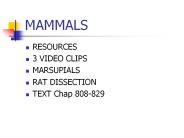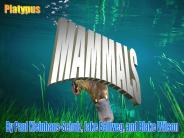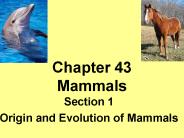Marsupials PowerPoint PPT Presentations
All Time
Recommended
Marsupials koalas wombat kangaroo wallaby possum sugar glider Tazmania Devil quolls numbat bandicoots bilby Marsupial mole Marsupials koalas wombat kangaroo wallaby ...
| PowerPoint PPT presentation | free to view
Marsupialia, Lagomorpha, and Insectivora Marie Rhodes Marsupials Typically has a pouch Differs from placental mammals in reproductive traits Embryo is born at early ...
| PowerPoint PPT presentation | free to view
BIAN3011 3 Marsupials up to the macropods
| PowerPoint PPT presentation | free to view
273 species, 18 families, & 7 orders in the Infraclass Metatheria ... non-reproductive opossums; dashed line at ~ 22 kcal = non-reproductive hamsters. ...
| PowerPoint PPT presentation | free to view
... combined allow for classification of stenotopic lineage Systema Naturae 2000 http://sn2000.taxonomy.nl/ Inca Shrew Opossum Lestoros Inca Chilean Shrew Opossum ...
| PowerPoint PPT presentation | free to download
MAMMALS RESOURCES 3 VIDEO CLIPS MARSUPIALS RAT DISSECTION TEXT Chap 808-829 MEDIUM 1. Name 5 marsupials. 2. I m a pinneped with great legs and a dog like face.
| PowerPoint PPT presentation | free to download
Fins- Projections that allow for turning and balance ... Koalas. Class Mammalia. Order Marsupials. Opossum. Wombat. Class Mammalia. Order Marsupials ...
| PowerPoint PPT presentation | free to view
Prototheria (monotremes) Metatheria (marsupials) The 3 subclasses of mammals differ strikingly in their modes of reproduction Eutheria (placentals)
| PowerPoint PPT presentation | free to view
Phylum and Subclasses Phylum: Mammalia Subclasses: Monotremes Lay eggs Marsupials Very immature young, females usually have pouches Placentals Develop young in ...
| PowerPoint PPT presentation | free to download
Counter-current ensures gradient exists continually ... Include platypus. Marsupials: Carry young in pouch. Ex: kangaroos, opposums ...
| PowerPoint PPT presentation | free to view
Motile during some stage of their life ... platypus. marsupials. kangaroo. placentals. bat, rabbit, dog, cattle, whale, human ...
| PowerPoint PPT presentation | free to view
MONOTREMES Egg laying Duckbilled Platypus Anteater Echidna MARSUPIALS Premature babies develop in pouch Found in Australia/New Guinea Kangaroo Wallaby ...
| PowerPoint PPT presentation | free to download
... marsupials (e.g., kangaroo), hippopotamus and hamster ... Colobine monkey, hamster, vole. Kangaroo, hippo. Hoatzin. Nonruminants. Grazing herbivores ...
| PowerPoint PPT presentation | free to view
f. Mammals: Reptile to Mammal' transitions - deep history: Pelycosaurs. Therapsids ... g. Mammals: - Development: - Lay eggs (Monotremes) - birth (Marsupials) ...
| PowerPoint PPT presentation | free to view
Sleeping Sickness David Humber Trypanosomes of Vertebrates T.corvi Corvids T.cruzi Humans, rodents, marsupials T.brucei sp Man, ungulates T ...
| PowerPoint PPT presentation | free to view
... Most successful group of mammals Placental Mammals Competitive advantage over monotremes and marsupials Better nutrition from ... Canine Premolars ...
| PowerPoint PPT presentation | free to view
Mechanisms to Rescue the CL. I. 'Conceptus secretes a product to stimulate CL function' ... Mechanisms to Rescue CL ... Examples: marsupials & dogs. ...
| PowerPoint PPT presentation | free to view
Classification of the house cat. Kingdom Animalia. Phylum ... Platypus and. Echidna (spiny anteater) Pouched mammals. Marsupials. Placental Mammals ...
| PowerPoint PPT presentation | free to view
... with a tropical climate Fauna In its wildlife can find different types of marsupials like koalas and kangaroos, monotremes, animals such as ...
| PowerPoint PPT presentation | free to download
Human embryo (5 weeks) Notochord attachment site for muscles ... Platypus. P. Chordata. Mammalia. Monotremes. Echidna. P. Chordata. Mammalia. Marsupials ...
| PowerPoint PPT presentation | free to view
Notochord: longitudinal, flexible rod located between the ... Monotremes (egg-laying): platypus; echidna. Marsupials (pouch): opossums, kangaroos, koalas ...
| PowerPoint PPT presentation | free to view
These animals, called marsupials, carry their young in a sack ... The Native People of Australia are called Aborigines. Warnings to Motorists. School Children ...
| PowerPoint PPT presentation | free to view
Gas Exchange Mammals are the only animals with a diaphragm, ... Marsupials pouched mammals Placentals mammals that carry their babies in a uterus, ...
| PowerPoint PPT presentation | free to download
Mammals can be found on. every continent, Mammals can be ... barracuda. human. GROUPS OF MAMMALS. Monotremes. Marsupials. Placentals. Short-beaked echidna ...
| PowerPoint PPT presentation | free to view
Length and evolutionary dynamics of vertebrate conserved non coding ... Mammal conserved CNC are much less conserved in marsupials (Margulies et al, PNAS 2005) ...
| PowerPoint PPT presentation | free to download
Describe the patterns and advantages of asexual reproduction in animals. ... ( EX: spiny anteater, platypus) Marsupials: give birth to partially developed live young. ...
| PowerPoint PPT presentation | free to view
Duck-billed platypus and spiny ant-eater. 3 sub-classes (continued) Marsupials ... Kangaroos, opossum, spotted cuscus, and giant anteater. Most found in Australia ...
| PowerPoint PPT presentation | free to view
Examples are the platypus and the spiny anteater. Marsupials which are mammals with pouches. ... Sloths, anteaters, armadillos. Lemurs, tarsiers, apes, gibbons, ...
| PowerPoint PPT presentation | free to view
Have a vertebral column, or backbone; this is made of ... spiny anteater and duckbilled platypus) Marsupials pouched mammals (ex. kangaroo and opossum) ...
| PowerPoint PPT presentation | free to view
Chapter 17 Mammals Marsupials Begin development within female s body born very immature development is completed within a pouch Attach to nipples of mammary glands ...
| PowerPoint PPT presentation | free to view
egg passes through cloaca. Marsupials: pouched mammals. ex. kangaroo, koala, opossums ... complete development in mother's uterus while nourishing fetus with a ...
| PowerPoint PPT presentation | free to view
... for natural sights, many of which are included in the list of the World heritage ... Many plants and animals, including huge marsupials, have died out with the ...
| PowerPoint PPT presentation | free to view
A baby kangaroo is called a Joey. Where does a kangaroo live? ... ( ZOO BOOKS) KANGAROOS by Beth Wagner Burst. Kangaroos and Other Marsupials by World Book, Inc. ...
| PowerPoint PPT presentation | free to view
... are the only marsupials outside the Australian region. ... There may be as many as 24 separate orders of placental animals. To what order do we belong? ...
| PowerPoint PPT presentation | free to view
... fishes 3x / day. ... A pan or box with a mixture of Fuller's earth & white sand placed ... The only North American marsupial. Marsupials s have pouch where ...
| PowerPoint PPT presentation | free to view
... American Marsupials ... nuts from trees such as red and white oak. Hickory and beech. ... Southern Flying Squirrel. Parents leave their young 65 days after ...
| PowerPoint PPT presentation | free to view
of Echidna) ... Groups: Mammals except Platypus and Echidna ... Types of mammals: Platypus and Echidna (lay eggs); non-placental (Marsupials: ...
| PowerPoint PPT presentation | free to view
K is for kangaroos who jump with hind legs. A is for always having a pouch. ... R is for red kangaroos. O is for only being marsupials. O is for often brown. ...
| PowerPoint PPT presentation | free to view
Chapter 43 Mammals Section 1 Origin and Evolution of Mammals Characteristics Endothermy- regulate own body temperature- metabolism Hair- all mammals have some hair ...
| PowerPoint PPT presentation | free to view
... kangaroo, wallaby, bandicoot, quokka, quoll, tasmanian devil, tasmanian tiger. About 280 species ... marsupial populations. Tasmanian Tiger. Diprotodon ...
| PowerPoint PPT presentation | free to view
Endothermy. 4 chambered heart. Diaphragm (muscle to aid breathing) Most nourished by a placenta ... Most groups live in Australia - mainly because Australia ...
| PowerPoint PPT presentation | free to view
Four ways birds are adapted for flight. Bones of a bird's forelimbs form wings ... There are two species of monotremes: spiny anteaters and duck-billed platypus. ...
| PowerPoint PPT presentation | free to view
... kangaroo Koala Wallaby ... short as or shorter than length of estrus cycle ... due to Red Kangaroo: Diet: Herbivore Average life span ...
| PowerPoint PPT presentation | free to view
MAMMALS. This is a mini lesson about mammals. ... An example of a monotreme is a duckbilled platypus. Next. What are placental mammals? ...
| PowerPoint PPT presentation | free to view
Evidence for Evolution Evolution on trial Earth is 4.6 billion years old and the oldest evidence of life is 3.6 billion years old. If this mechanism of change has ...
| PowerPoint PPT presentation | free to download
... wombat 250 species pouched mammals Show Koala video here Koala Bear Tasmanian Devil Flying Phalangers Wombat opossum Kangaroo young born very helpless after ...
| PowerPoint PPT presentation | free to download
... rhinoceros, & tapirs Location: Africa & Asia Have a cecum Order Cetacea Whales, dolphins, porpoises Lack hind-limbs, have tails Totally aquatic, ...
| PowerPoint PPT presentation | free to view
Includes most mammals we think about - whales, bats, elephants, shrews, and armadillos ... 6' at shoulder; could kill a modern elephant. Big guys ...
| PowerPoint PPT presentation | free to view
A Beaver. 5/25/09. What is a Mammal. 14. Is this a Mammal? A Lady Bug. 5/25/09. What is a Mammal ... YES. Lady Bug. NO. YES. Beaver. NO. YES. Spider. No. Yes ...
| PowerPoint PPT presentation | free to view
Plate Tectonics What is it and what makes it work? Oceanography Pea-soup analogy mantle convection Heat transfer from the core to the mantle Produces slow convection ...
| PowerPoint PPT presentation | free to view
Figure 34.2 Echinodermata Cephalochordata ANCESTRAL DEUTEROSTOME Chordates Urochordata Notochord Myxini Craniates Common ancestor of chordates Petromyzontida
| PowerPoint PPT presentation | free to view
Species that are more closely related tend to have more similarities in their DNA ... that give birth to live young that develop in an outer pouch of the mother. ...
| PowerPoint PPT presentation | free to view
The Australian savanna is one of the world's largest tropical savannas. ... Dingo. Kangaroo. A kangaroo is a marsupial. How can you tell? Rabbit. Donkey. Wombat ...
| PowerPoint PPT presentation | free to view
most develop in the uterus where they are nourished by a placenta ... Opossum, koala, wallaby, wombat, kangaroo, and Tasmanian Devil...
| PowerPoint PPT presentation | free to view
Cenozoic Life Age of Flowers
| PowerPoint PPT presentation | free to download
Mammals are capable of regulating their own body temperature. ... The echidna, also known as a spiny anteater, lives in Australia. ...
| PowerPoint PPT presentation | free to view
























































